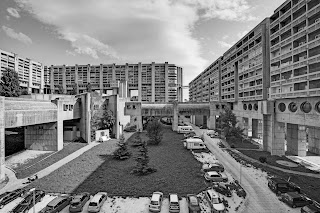Lo sviluppo dei quartieri nelle grandi città italiane dagli anni 60 fino agli anni 80 hanno creato strutture residenziali di varie forme, quasi mai centrando l'obiettivo iniziale di funzionalità e vivibilità con cui sono state edificate. Un seguito nazionale all'idea di Le Corbousier e la famosa legge 167 hanno dato vita a qualcosa di irreversibile, tanto per citare alcune zone famose: lo ZEN a Palermo, il chilometro del Corviale a Roma, le Vele di Napoli Scampia, la "Virgola" di Bologna, il CEP di Genova, Rozzol Mealara a Trieste. Scoprii piano piano l'esistenza di questi luoghi, un po' preso dalla curiosità e dalle leggende che vi ruotavano intorno, un po' per la necessità di vedere come realmente si stato possibile la loro costruzione. Ancora ragazzo presi la fidanzata e vagai in un misto di adrenalina e paura tra gli scempi edilizi di Genova, la prima grande città alle porte di casa, visitai, il CEP di Voltri, le "Lavatrici" di Prà, poi solo il "Biscione" di Quezzi e solo più tardi il famigerato Begato e la sua diga, qualcosa mi colpiva ogni volta violentemente dentro, come entrare in un segreto, palazzi fitti come alveari, infinite storie in altrettanti particolari, mi chiedevo talvolta quante erano le cantine in cui qualcuno ha giocato all'astronave, o in quante stanze qualcuno si era immaginato un'aldilà alternativo alla realtà chiudendo gli occhi dopo aver sbirciato il lato verde azzurro sulla costa di uno specchio come ho fatto io da bambino in un appartamento residenziale in una tranquilla borgata di pochi abitanti distante dalla grande città. Ecco ora che c'ero dentro quei luoghi non mi facevano più paura, ma a poco a poco mi svelavano le loro storie, la loro decadenza, gli anni 80 bui dell'eroina e la conseguente invivibilità, la semplicità di chi è stato costretto ad andare avanti, ma soprattutto l'umanità che popolava quegli edifici altrimenti vuoti e irrazionali.
Oggi venendo per la prima volta a guardare quel porto di mare speculare alla mia terra, non ho potuto resistere a venire a vedere il Rozzol Melara qui a Trieste, dopo un poco d'esitazione nello spoglio parcheggio sull'angolo basso del quadrilatero sul lato sloveno mi ci sono immerso dentro, fotocamera al collo e il mostro non mi ha fatto più paura, i denti marci di qualcuno e il cemento armato grigio decadente e impattante, poi le viscere. Il mio non è un racconto o una profonda riflessione che vi voglio trasmettere, il mio è solo uno sguardo che ha attraversato questo progetto edilizio visibile fin dal mare a sovrastare questa città sorprendentemente piacevole e viva. Ognuno ci veda ciò che vuole a voi le riflessioni. Buona visione
English
The development of the neighborhoods in major Italian cities from the 60s up to the 80s have created residential structures of various shapes, almost never hitting the initial target of functionality and livability with which they were built. Following a national idea of Le Corbusier and the famous Law 167 have created something irreversible, just to remind the name of some famous areas: the ZEN in Palermo, the kilometer of Corviale in Rome, the Sails of Scampia, Naples, the "Comma "Bologna, the CEP of Genoa, Rozzol Mealara in Trieste. Slowly discovered the existence of these places, a bit out of curiosity and legends that revolved around a bit for the need to see how it really was possible to build it, When I was a young boy I took girlfriend and wandered into a mixture of adrenaline and fear among this kind of construction in Genoa, the first major city next to the door's house, I visited, the CEP Voltri, the "Washing Machine" Prà, then I went alone at "Snake" of Quezzi and only later the infamous Begato and His dam, something struck me every time violently inside, like entering in to a secret, palaces thick as hives, endless stories in it as their many details, I wondered how many times where someone played the starship in to the cellars, or how many rooms someone he was imagined afterlife alternative reality closing his eyes after peeking side blue-green on the coast of a mirror as I did when I was a child. Now, that was inside those places did not make me more afraid, but gradually show me their stories, their decline, the 80s dark heroine years and the consequently hard life for all, the simplicity of those who were forced to go ahead, but also the personalities that populated those otherwise empty buildings and irrational.
Today coming for the first time to see the port mirror of my land, I could not resist coming to see the Rozzol Melara here in Trieste, after a little hesitation in the bare parking on the corner of the lower wishbone on the Slovenian side I got dipped inside, camera around my neck and the monster did not make me more afraid, rotten teeth of someone and concrete gray decadent and impressive, then the bowels. Mine is not a story or a deep reflection that I want to convey, mine is just a look that went through this construction project visible from the sea to drown this city surprisingly enjoyable and alive. Everyone will see what he wants, you can choose how to have reflections. Good vision













